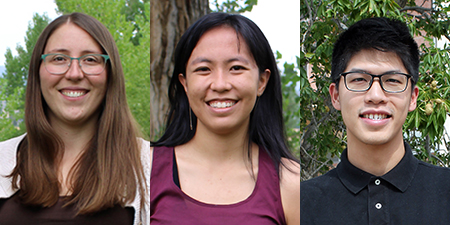Kimberley Corwin, Bee Leung, Kevin Yang receive NASA Future Investigators awards
Kimberley Corwin, Gabrielle “Bee” Leung and Chen-Kuang “Kevin” Yang have been selected for the Future Investigators in NASA Earth and Space Science and Technology (FINESST) program. FINESST awards funding for research projects that are designed and executed by graduate students and contribute to NASA’s science, technology and exploration goals. Corwin’s, Leung’s and Yang’s proposals were three of 62 selected from 394 submitted to the Earth Science Division, out of 932 proposals overall. The grant may be applied for up to three years.
Corwin and her adviser, Associate Professor Emily Fischer, will research how wildfire smoke impacts solar energy generation in the U.S. using a combination of satellite observations, radiative transfer and atmospheric chemistry models, solar energy production datasets, and solar resource models. They will assess the historical exposure of solar resources to smoke and quantify associated changes in solar generation. Using estimates of future fire emissions that account for different climate, population and emissions scenarios, they will estimate changes to surface shortwave radiation and compare these results to solar energy capacity and cost projections across the U.S.
“We need to make sure that solar forecasting accounts for how wildfire smoke will affect solar panels, especially as wildfires grow larger and more frequent with climate change,” Corwin said. “I’m excited for the opportunity to work on an important interdisciplinary question and thankful for the support provided by NASA FINESST.”
Leung will work with her adviser, University Distinguished Professor Sue van den Heever, to understand how changes to land surface, for example through deforestation or urbanization, impact tropical cloud properties in conjunction with changes to the aerosol environment. They will focus on the Maritime Continent, a region of the world undergoing rapid changes to both land cover and aerosol emissions.
“There is still a lot of disagreement about whether land-cover changes in the region would increase or decrease precipitation overall,” Leung said. “It’s a very complicated problem, since changing the land cover consists of simultaneous changes to many physical parameters, such as latent and sensible heat fluxes, surface roughness and convergence, and aerosol sources.”
They will use a combination of satellite observations, realistic region-scale modeling and idealized large eddy simulations to quantify the magnitude of aerosol-land surface impacts on convection and explore the mechanisms driving those impacts.
Yang and his adviser, Associate Professor Christine Chiu, will assess the role of near-cloud aerosols in the radiation budget using retrievals from 3D radiative transfer and machine learning. They will develop a new method that incorporates 3D cloud radiative effects and aerosol hygroscopic growth for retrieving near-cloud aerosol properties, using shortwave reflectance observations from MODIS (the Moderate Resolution Imaging Spectroradiometer satellite instrument). The project is expected to provide new global and regional estimates of aerosol direct radiative effects that include near-cloud aerosols for the first time. They also will exploit the new aerosol retrievals to study the variability of aerosol direct radiative effects with organizations of shallow cumulus and to understand the implication for a warmer climate.
“This research tackles the outstanding issue in the aerosol remote sensing community and could potentially change the current state of the aerosol direct radiative effect estimate,” Yang said. “I am very excited and grateful for the opportunity from NASA FINESST to do such exciting work.”



